Previous : How Do We Know Methane is Tetrahedral?
Today’s post is all about hybrid orbitals. Here’s a quick summary:

1. What Orbitals Are Involved In The Tetrahedral Arrangement Of Methane (CH4)?
In the last post on the structure of methane we asked how we know that methane is tetrahedral.
Based on the orbitals of carbon (2s and 2p) we might have naively expected three of the C-H bonds to line up along the x, y, and z axes, respectively, and have the other one at some arbitrary angle (like 135° or so)
But then, as so often happens in science, our beautiful intuitive hypothesis was destroyed by some annoying experimental facts:
- methane has no measurable dipole moment (our “reasonable” structure, below left, would be expected to have a measurable dipole moment)
- the crystal structure of diamond is tetrahedral, with identical bond lengths and angles between carbons of 109.5 degrees. This isn’t what we’d expect if we were dealing with bonds between “pure” 2s and 2p orbitals!
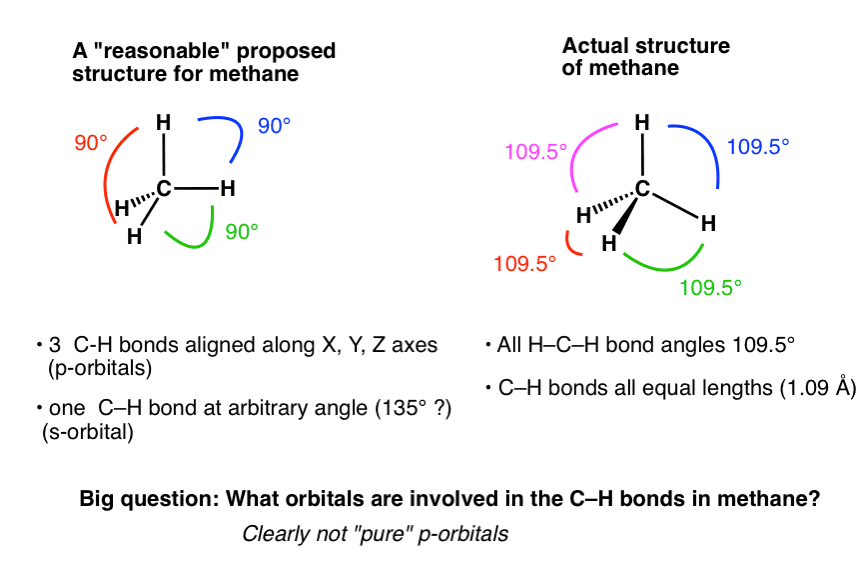
In retrospect, the geometry makes sense. It happens that 109.5 degrees is the orientation that maximizes the distance between each of the four bonding pairs, and thus minimizes their repulsive interactions. In other words, the geometry is a direct consequence of “opposite charges attract, like charges repel“.
But how do we describe the orbitals that are used to give that bond angle?
This is a real chin-scratcher. They can’t be pure 2s orbitals (there’s only one 2s orbital, anyway). And they can’t be pure p orbitals, since the p orbitals are aligned at 90° to each other.
So what the heck kind of orbitals are they?
2. Hybrid Orbitals: An Explanation For Bonding At Carbon
Linus Pauling asked this same question back in his classic treatise, the Nature of the Chemical Bond (1931) which in large measure won him the 1954 Nobel Prize in Chemistry.
Pauling’s solution to this dilemma, which we still apply today, was the following:
- None of the bonding orbitals in methane are 100% s or 100% p. Instead, they are hybrid orbitals that each have partial s character and partial p character.
- The three 2p orbitals and the single 2s orbital hybridize (i.e., mix) to create four hybrid sp3 orbitals, which are arranged tetrahedrally around the central carbon atom.
- Each of the four hybrid orbitals has 25% s-character and 75% p-character.
- In the case of methane, each of these sp3 hybrid orbitals overlaps with a 1s orbital from hydrogen to form the C-H bonds

I’ll be honest here. Many students don’t like this explanation.
Certainly, it’s confusing at first. Why?
I think that when we initially learn about orbitals, we intuitively think of them as containers – sort of like atomic Tupperware for holding electrons that happen to come in a variety of cutesy shapes.

Electrons, then, can be imagined to behave like the “fruits” that rattle around in these containers (strict limit: 2 per container!). It’s not so surprising to our intuition when we learn that they can move from container to container within an atom or even leave the atom altogether.
What is surprising is when we open up the fridge and find that our cute little sphere- and dumbbell-shaped Tupperware containers have changed their shape and merged their properties with each other! This violates our intuition about how containers behave!
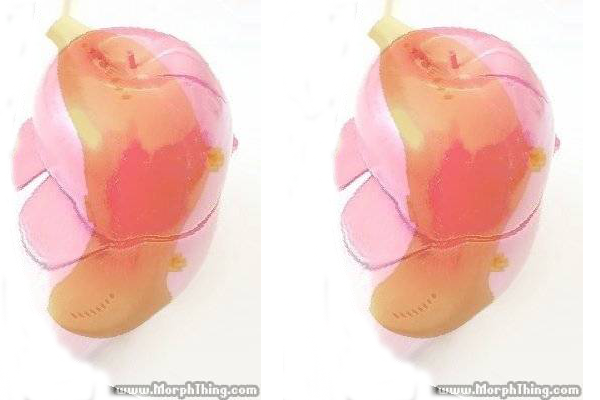
This is the quantum world, folks! If this doesn’t mystify you… it f*&king should!
Going forward, I don’t ask that you understand or even “believe in” hybridization on a deep mathematical or theoretical level. That’s not necessary for our purposes.
I merely advise that you try to suspend your disbelief going forward, because using this hybridization model will help us rationalize a lot of molecular structure, geometry, and behaviour.
3. A Pop Analogy: Hybrid Soda
Before we dive in any further, here’s what I consider to be a helpful little analogy that might help to get the point across.
- Imagine you have four bottles of pop: one bottle of Sprite (S) and three bottles of Pepsi (P).
- Now imagine pouring them out, mixing them all together, and then re-filling each bottle with the mixture.
- The Law of Conservation of Pop says that you still have four bottles worth of liquid. But now the pop is neither pure Sprite or pure Pepsi; it is a hybrid between the two.
- Specifically, each bottle now has 25% Sprite character and 75% Pepsi character.
- We can call this “hybrid” pop, if you like, sp3
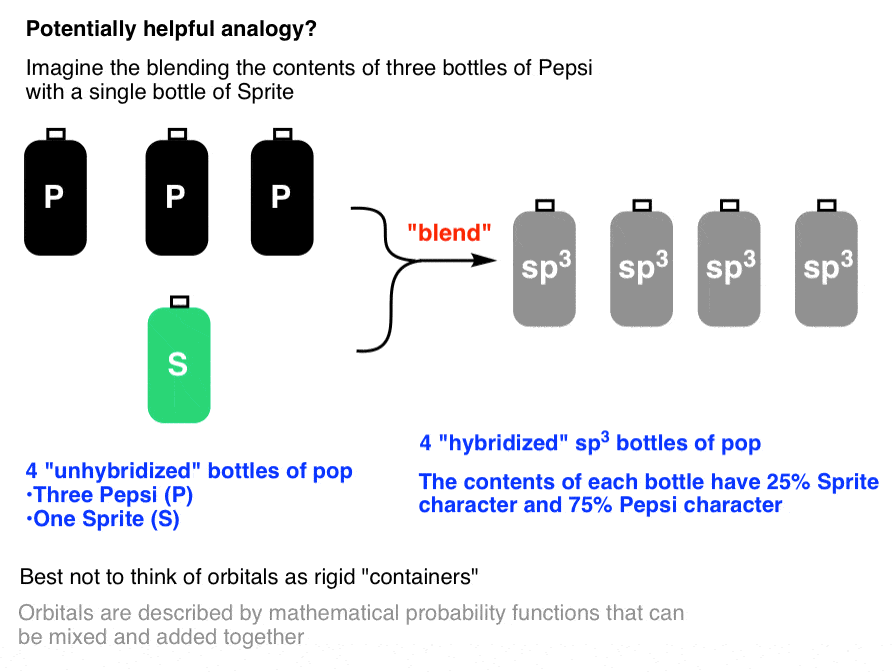
That’s a little bit like what has happened to our 2s and 2p orbitals. By mixing the 2s and three 2p orbitals, we now have four orbitals which have 25% s character and 75% p character. (Although, importantly, it’s the shapes of the bottles that are changing, not just the contents).
The final step is to arrange these four orbitals at the corners of a tetrahedron, which allows for the maximum distance between the four electron pairs (like charges repel!)
How does this rationalization help us?
- It explains the tetrahedral molecular geometry of methane, with 4 identical H–C–H bond angles (109.5°)
- It explains the 4 identical C–H bond lengths (and bond strengths) in methane
- It explains the lack of a dipole moment in methane, since the tetrahedral arrangement of the electron pairs allows for all partial charges to cancel (i.e. the vectors sum to zero)
- The model even helps to rationalize how certain reactions occur, which we won’t go into right now [e.g. backside attack in the SN2 reaction occurs into the empty “antibonding” orbital 180° to the bonding C–H orbital, if you’ve been reading ahead]
4. sp3 Hybridization Accurately Describes The Arrangement Of Atoms In (First-Row) Elements Bonded To Four Atoms…
This doesn’t just apply to methane. It applies to any situation where a (first-row) element is bonded to four atoms. Obviously tetrahedral carbon is the most prominent example we will explore, but it also applies to tetrahedral nitrogen [e.g. NH4(+)] and even tetrahedral boron [e.g. BF4(-)].
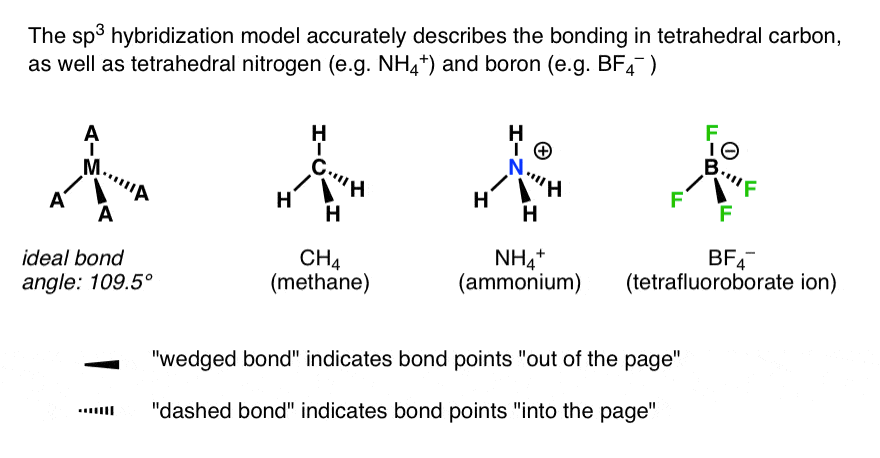
5….As Well As Situations Where The Number of [Atoms + Lone Pairs] Equals 4
The tetrahedral arrangement of the orbitals holds even when one or more pairs of electrons is a non-bonded lone pair (If you’ve run across VSEPR theory, which most people have by the time that they arrive in organic chem, this shouldn’t come as a shock.)
For instance, ammonia (NH3), the “methyl anion” (CH3 – ) and the hydronium ion (H3O+) all have a central atom with 4 pairs of electrons: 3 pairs of bonding electrons and one pair of non-bonded electrons. As we’ve seen, the ideal geometry for arranging four pairs of electrons is tetrahedral, which makes the hybridization of the central atom sp3. This leaves the molecule with a “piano stool” arrangement of atoms about the central atom, which we call “trigonal pyramidal” geometry.

Another way of putting it is that the central atom has tetrahedral orbital geometry (sp3) and trigonal planar molecular geometry.
An interesting fact is that the bond angles in these are compressed from the ideal angle of 109.5°. The H-N-H bond angles in ammonia, for instance, are 107 degrees. We rationalize this as being due to the fact that a non-bonded lone pair is more repulsive than a “normal” bonding pair – likely because it’s closer to the atom and exerts a stronger influence.
This deviation from “ideal” bond angles is even greater in H2O (water) which has two lone pairs. The hybridization is still sp3, the orbital geometry is still tetrahedral, but the shape (“molecular geometry”) of the resulting molecule is “bent”.
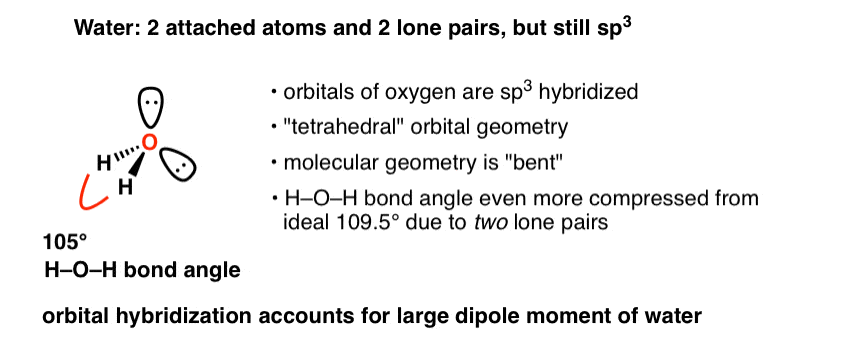
Indeed, one of the notable achievements of Pauling’s hybridization model is that it correctly accounts for the dipole moment of water. If water were perfectly “linear”, as many of us might have naively assumed before we learned any chemistry, the dipoles would cancel each other out.
Another example of “bent” geometry is found in the amide anion NH2– which has two lone pairs on nitrogen.
A quick table might help to summarize everything we’ve established about sp3 hybridization:
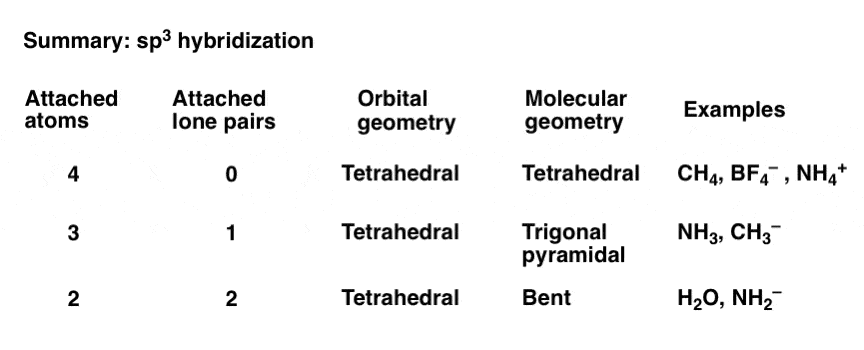
6. sp2 Hybridization
Let’s go back to our pop-bottle analogy. Say we only mix our Sprite with two bottles of Pepsi, not three.
What does that leave us with?
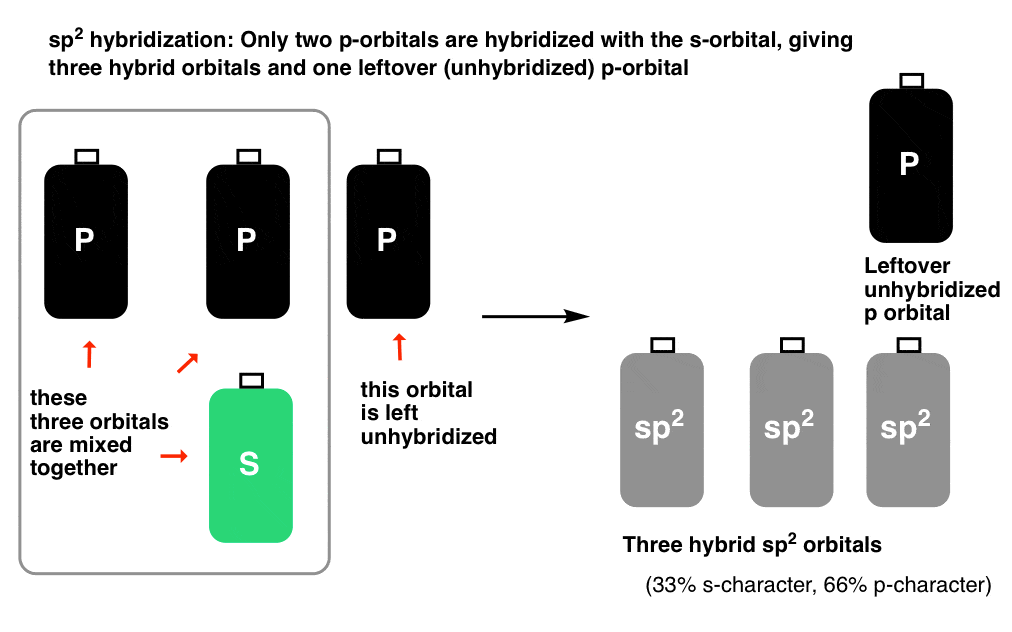
This gives us three hybrid bottles of pop, and one leftover unhybridized bottle.
By analogy, if we mix the 2s orbital with two 2p orbitals, we obtain three sp2 hybrid orbitals, and one left over, unhybridized p orbital.
When these three sp2 orbitals are filled with electron pairs, the bond angle that maximizes their distance apart is 120°.
This gives us a “trigonal planar” arrangement of sp2 orbitals, with the unhybridized p orbital at right angles to the plane. It kind of resembles a Mercedes Benz symbol.

A classic example of this trigonal planar geometry is seen in borane, BH3 , which has three pairs of bonding electrons arranged at 120° to each other. The trigonal planar geometry is also found in carbocations, such as the methyl cation, CH3+ .
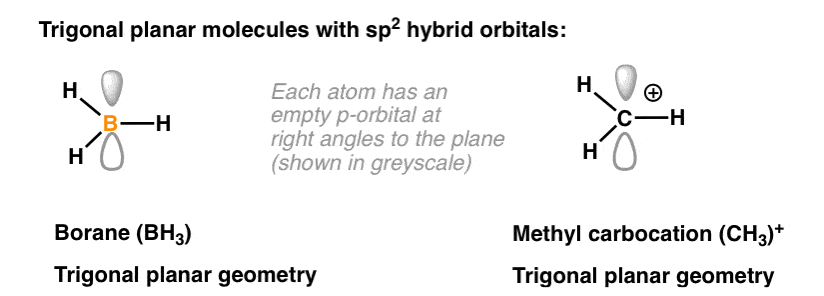
You might wonder: where is the unhybridized p orbital?
At right angles to the plane. Recall that each of the three p orbitals are at right angles to each other. So whichever two p-orbitals hybridize, the third (leftover) p orbital will be at right angles to the plane that they form (just like the z axis is perpendicular to the xy plane)
In the case of BH3 and carbocations, the unhybridized p-orbital is empty.
There is another very common situation where sp2 geometry is observed, however. If adjacent atoms have single electrons in unhybridized p-orbitals, and if those p-orbitals can overlap, a bond can result. This is a phenomenon known as “pi-bonding“. (We’ll have a lot more to say about it later.)
Pi bonds – which are often just called, “double bonds” – require an unhybridized p orbital in order to form.
The carbon, oxygen, and nitrogen atoms in the examples below, which all have pi bonds (double bonds) are sp2 hybridized. The orbitals are separated by angles of approximately 120°.
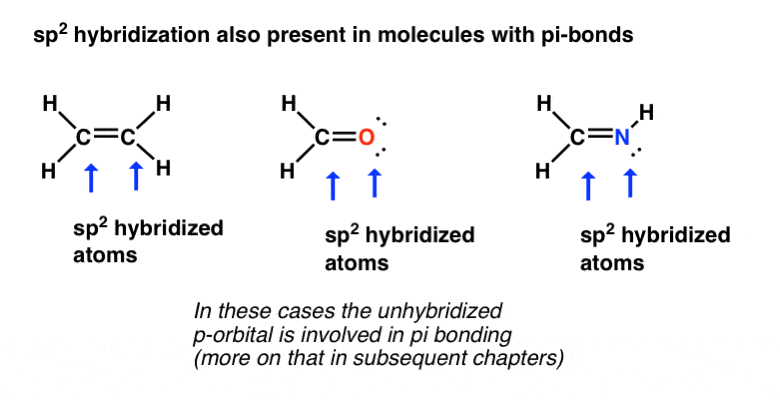
Note that lone pairs can be in sp2-hybridized orbitals, just as we saw in NH3 and H2O in the case of sp3 hybridization. Also note that in the midde molecule (formaldehyde), the oxygen has two lone pairs (each in sp2 hybridized orbitals) and in the top right molecule the nitrogen has a single lone pair in a sp2 hybridized orbital.
When a lone pair is present, the bond angles will be slightly less than 120° since the lone pair can be thought of taking up more “room”.
7. sp Hybridization
Let’s examine the last possible case. What if only one p orbital hybridizes with the s orbital?
This gives us two hybrid ” sp ” orbitals separated by the maximum angle apart: 180 degrees. We call this arrangement, “linear”. Each hybrid sp orbital has 50% s character and 50% p character.
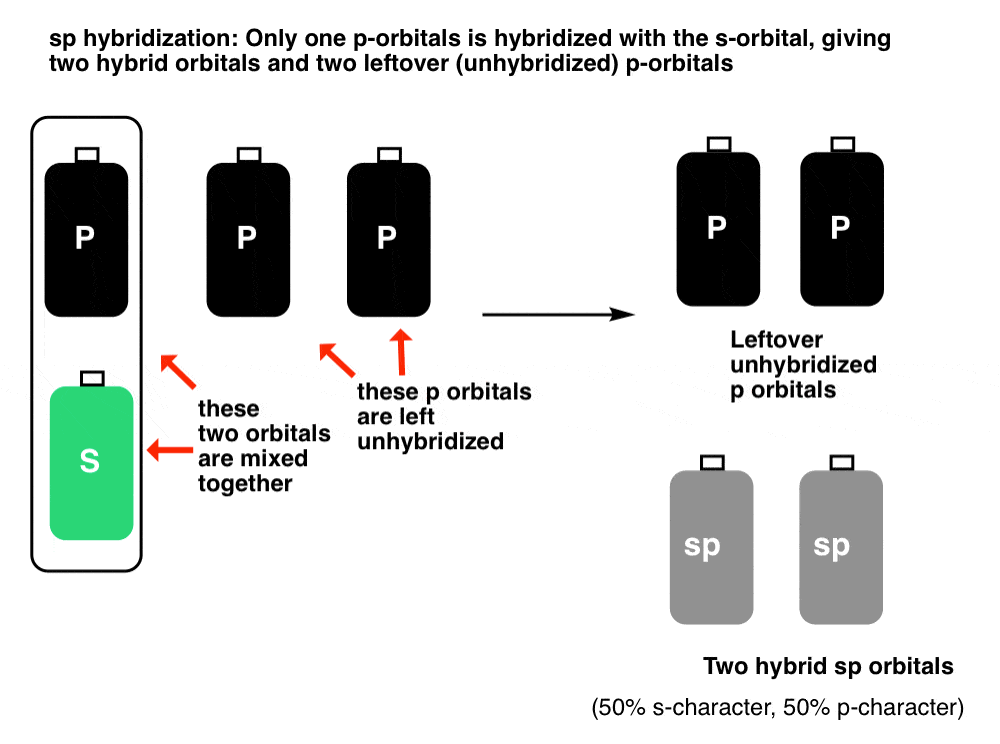
The two unhybridized p-orbitals are each at right angles to the sp hybrid orbitals.
For instance, here’s what the orbitals look like in beryllium chloride (BeCl2) where the Cl-Be-Cl bond angle is 180°. If we consider the Cl-Be-Cl bond to be along the x-axis, the two (unhybridized) p-orbitals will be along the y and z axes, respectively.
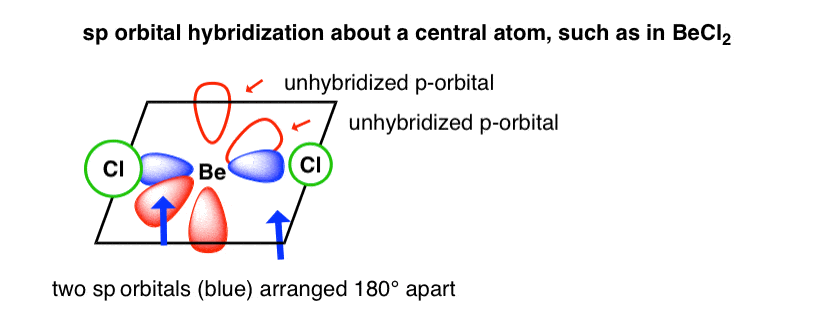
sp-hybridization is more commonly observed in situations where there are two pi bonds on a single atom. The most prominent examples are “triple bonds”, as seen in alkynes, nitriles, and carbon monoxide (CO). In these cases, not only are the carbon atoms sp-hybridized, but so are the nitrogen (in nitriles) and oxygen (in carbon monoxide) atoms.
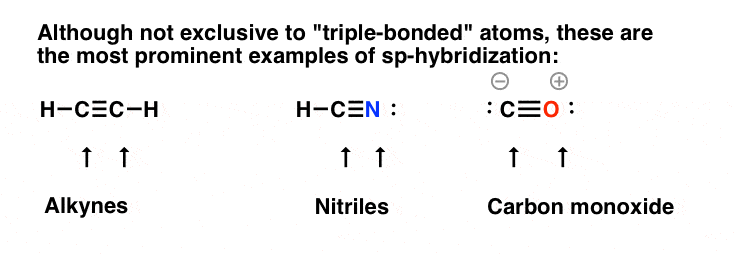
Note also that lone pairs can be in sp-hybridized orbitals, as seen in nitriles and carbon monoxide.
sp-hybridization is not exclusive to triple bonded atoms – for example, the central carbons in allene and ketene participate in two pi bonds and are therefore sp-hybridized – but triple bonds are the most immediately recognizable examples.
8. Summary – Hybrid Orbitals
OK. Here are the main points of this unintentionally very long post:
- Electron pairs repel. In the absence of orbital hybridization, the bond angles around CH4 would be confined to the geometry of the p-orbitals (90°). It’s energetically favorable for the s and p orbitals to hybridize to form sp3 orbitals which results in a greater separation of the electron pairs and bond angles of 109° (i.e. at the apices of a tetrahedron). This also holds for central atoms with non-bonding electron pairs such as NH3 and H2O.
- When only two p orbitals participate in hybridization, three sp2 hybrid orbitals result that adopt a trigonal planar orbital geometry. The remaining (unhybridized) p orbital, which is at right angles to the trigonal plane, can either be empty (as in BH3) or singly-occupied (as seen in molecules containing pi bonds).
- When only one p orbital participates in hybridization, the result is two sp hybrid orbitals and a linear orbital geometry. The two remaining p orbitals are available for pi-bonding (as in triply-bonded organic compounds such as alkynes and nitriles) or can be empty (as in BeCl2).
- Note that the number of orbitals around the central atom is always 4. Orbitals are neither created nor destroyed by hybridization; they are merely transformed.

In the next post we will just provide a super simple trick for quickly determining the hybridization of a central atom.
